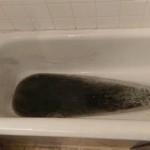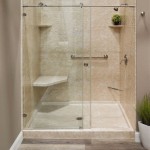Acrylic Bathtub Vs. Fiberglass Shower: A Detailed Comparison
Choosing between an acrylic bathtub and a fiberglass shower often presents a dilemma for homeowners renovating bathrooms or building new homes. Both materials offer distinct advantages and disadvantages, and understanding these differences is crucial for making an informed decision that aligns with one's budget, aesthetic preferences, and long-term needs. This article provides a comprehensive comparison of acrylic bathtubs and fiberglass showers, examining their material properties, durability, cost, maintenance requirements, and installation considerations.
Fiberglass, a composite material made by reinforcing plastic with glass fibers, has traditionally been a popular choice for bathtubs and showers due to its affordability and lightweight nature. Acrylic, a type of plastic, offers superior durability and design flexibility but typically comes at a higher price point. The construction methods for each material also contribute to the final product's characteristics and performance. Understanding these underlying factors is key to evaluating which option best suits specific requirements.
This comparison will explore the nuances of each material, objectively examining their strengths and weaknesses to assist in navigating the decision-making process. The goal is to provide a clear understanding of the attributes of both acrylic bathtubs and fiberglass showers, enabling homeowners to confidently select the option that optimally meets their needs and expectations.
Durability and Longevity: A Crucial Distinguisher
The durability of a bathtub or shower directly impacts its longevity and overall value. While both acrylic and fiberglass can withstand daily use, their resistance to damage varies significantly. Acrylic bathtubs are generally considered more durable and resistant to scratches, cracks, and fading compared to fiberglass showers. This is primarily due to acrylic's solid surface composition. Scratches on acrylic surfaces can often be buffed out, restoring the original finish. Furthermore, acrylic bathtubs tend to retain their color and shine for a longer period, maintaining their aesthetic appeal over time.
Fiberglass showers, on the other hand, are more susceptible to damage. The gel coat that provides the surface finish on fiberglass can chip or crack relatively easily, especially under heavy impact. Scratches on fiberglass are also more difficult to repair, and the material can become stained or discolored over time. The porous nature of fiberglass can also lead to mold and mildew growth if not properly maintained. While fiberglass showers can last for a reasonable period with careful use, their lifespan is generally shorter than that of acrylic bathtubs.
The construction process also plays a role in durability. Acrylic bathtubs are often reinforced with fiberglass backing for added strength and stability. This combination provides the benefits of both materials, resulting in a durable and long-lasting product. Fiberglass showers, while sometimes reinforced, often lack the same level of robustness, making them more prone to flexing and cracking under weight or stress.
Ultimately, the choice between acrylic and fiberglass based on durability depends on the anticipated usage and the level of care the product will receive. For high-traffic bathrooms or households with children, acrylic bathtubs may offer a more resilient and long-lasting solution. For less frequently used bathrooms or situations where budget is a primary concern, a well-maintained fiberglass shower can still provide adequate performance.
Cost Analysis: Initial Investment and Long-Term Expenses
The initial cost of an acrylic bathtub is typically higher than that of a fiberglass shower. This price difference reflects the superior materials and more complex manufacturing processes involved in producing acrylic products. Fiberglass showers, being made from less expensive materials and using simpler production techniques, offer a more budget-friendly option upfront.
However, the long-term cost considerations extend beyond the initial purchase price. The superior durability of acrylic bathtubs can translate into lower maintenance and repair costs over the product's lifespan. The resistance to scratches and cracks, as well as the ease of repairing minor damage, can help avoid costly repairs or replacements. In contrast, fiberglass showers, being more prone to damage, may require more frequent repairs or even replacement sooner than an acrylic bathtub.
Installation costs can also influence the overall cost analysis. Both acrylic bathtubs and fiberglass showers can be professionally installed or installed as a DIY project. However, the weight and complexity of installing an acrylic bathtub may require professional assistance, adding to the overall expense. Fiberglass showers, being lighter and easier to handle, can be more readily installed by a homeowner with moderate DIY skills, potentially saving on labor costs.
When evaluating the cost-effectiveness of acrylic bathtubs and fiberglass showers, it is crucial to consider both the upfront investment and the potential long-term expenses. While fiberglass showers may appear more appealing due to their lower initial price, the increased durability and reduced maintenance requirements of acrylic bathtubs can make them a more cost-effective choice in the long run. A careful assessment of individual needs, budget constraints, and anticipated usage patterns is essential for making an informed decision.
Aesthetics, Design Flexibility, and Maintenance
Acrylic bathtubs offer greater design flexibility compared to fiberglass showers. Acrylic can be molded into a wider range of shapes, sizes, and styles, allowing for more customization and personalization. This versatility makes acrylic bathtubs a popular choice for homeowners seeking to create a unique and aesthetically pleasing bathroom design. The smooth, non-porous surface of acrylic also provides a sleek and modern appearance.
Fiberglass showers, while available in various configurations, are typically limited in their design options. The manufacturing process for fiberglass restricts the complexity of the shapes and patterns that can be achieved. However, fiberglass showers are available in a variety of colors and finishes, allowing them to complement different bathroom decor styles. The gel coat surface of fiberglass can provide a glossy and attractive appearance when properly maintained.
Maintaining the appearance and cleanliness of both acrylic bathtubs and fiberglass showers is essential for preserving their longevity and hygiene. Acrylic surfaces are generally easier to clean and maintain due to their non-porous nature. Simple cleaning solutions and a soft cloth are typically sufficient for removing soap scum, dirt, and grime. The smooth surface of acrylic also resists the build-up of mold and mildew.
Fiberglass showers require more diligent cleaning and maintenance to prevent staining, discoloration, and mold growth. The porous nature of fiberglass can trap dirt and moisture, creating a breeding ground for mold and mildew. Regular cleaning with specialized fiberglass cleaners is recommended to maintain the appearance and hygiene of the shower. Additionally, it is important to promptly repair any chips or cracks in the gel coat to prevent water from seeping into the fiberglass and causing further damage.
The choice between acrylic and fiberglass based on aesthetics and maintenance depends on personal preferences and lifestyle. If a wide range of design options and ease of maintenance are priorities, acrylic bathtubs may be the preferred choice. If budget is a primary concern and diligent cleaning is not an issue, a fiberglass shower can provide an acceptable aesthetic and functional solution.
In conclusion, the selection between an acrylic bathtub and a fiberglass shower involves a thorough evaluation of various factors. Durability, cost, aesthetics, maintenance, and installation considerations all play a significant role in the decision-making process. By carefully weighing the advantages and disadvantages of each material, homeowners can make an informed choice that aligns with their specific needs and priorities.

Acrylic Vs Fiberglass Tub What S The Difference American Standard Walk In Tubs

Acrylic Vs Fiberglass Tub Which Material Is Best For You

Bathtubs Showers Acrylic Vs Fiberglass Home

Can Plastic Acrylic Or Fiberglass Bathtubs Shower Stalls Be Reglazed Refinished America Refinishing Pros

Bathtubs Showers Acrylic Vs Fiberglass Home

What Bathtub Material Is In My Bathroom Maryland Tub Tile

Acrylic Vs Fiberglass Tub What S The Difference

The Disadvantages Of Fiberglass Bathtubs And Showers

Should You Choose A Fiberglass Or Acrylic Tub

Acrylic Vs Fiberglass Shower Which Is Better
Related Posts








